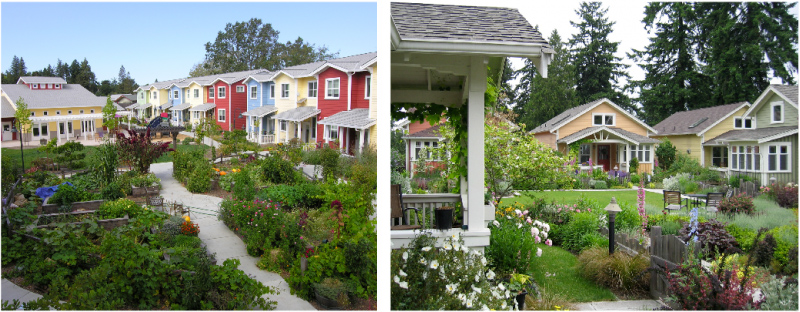
Cohousing communities are intentional by nature, with residents purposely coming together around shared values and commitments. In Pocket Neighborhoods, a sense of community may arise naturally among neighbors by the fact of living around a commons, and may be augmented with more intention. (left: Petaluma Avenue Cohousing /photo by Grace Kim; right: Greenwood Avenue Cottages /photo by Karen DeLucas)
Cohousing has been taking hold across North America and around the world, offering an enticing option for people wanting to live in a more closely knit community. Some even call it a movement. Pocket Neighborhoods are being tossed around as a viable housing approach within existing neighborhoods, as well as sub-neighborhoods within larger new developments. Both foster a sense of community by design; but what’s the difference between the two?
Pocket neighborhoods, by our definition, are clusters of nearby neighbors around a shared commons of some sort — micro-neighborhoods with a scale of sociability. They are the physical arrangements of houses or apartments, or even trailers, designed to foster neighborly interactions while preserving personal privacy. A sense of community may arise naturally (more or less) among its residents by the fact that everyone lives around a commons.
In cohousing, community is intentional. Future residents purposely come together around clearly defined shared values and visions, and then plan and build the physical environment*, and manage the community once it is built. Residents are expected to take part in regular team-cooked meals, be on committees and engage in shared responsibilities. Decisions and disputes are handled as much as possible through consensus. Social life of the residents is often centered among members of the community.
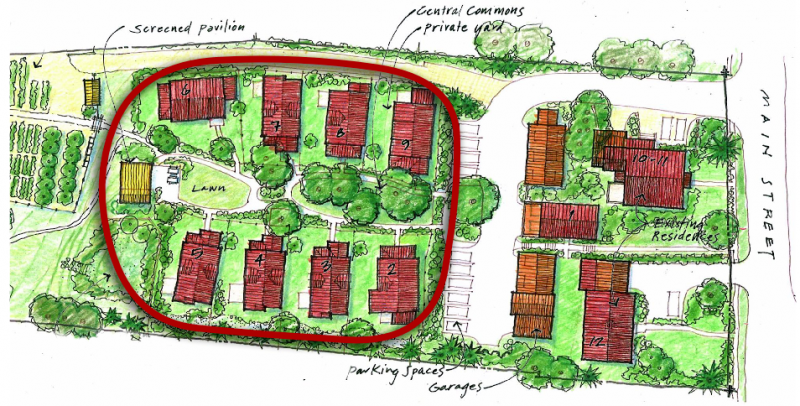
A classic cottage courtyard pocket neighborhood tucked behind two existing houses on a town street.
I am arriving at a strong conviction that the social health of pocket neighborhoods depends significantly on the degree to which residents share intentions and a set of tools to make shared decisions, resolve disputes and cultivate community life. I don’t think residents have to take part in the tedious and time-intensive process for land acquisition, zoning entitlements, planning & design, and construction. I do, however, recommend that any developer of a pocket neighborhood engage a communities facilitator to help clarify provisional intentions and work with new residents on establishing a healthy community culture. Is this “cohousing”? Some will argue no. As I see it, though, this approach honors the spirit of cohousing and helps spread its roots into broader fields. We all benefit by having wider community-oriented housing opportunities.
One example of this approach is the Fifth Street Commons on Whidbey Island. We took the initiative to repurpose a depressed apartment complex into a revitalized community.
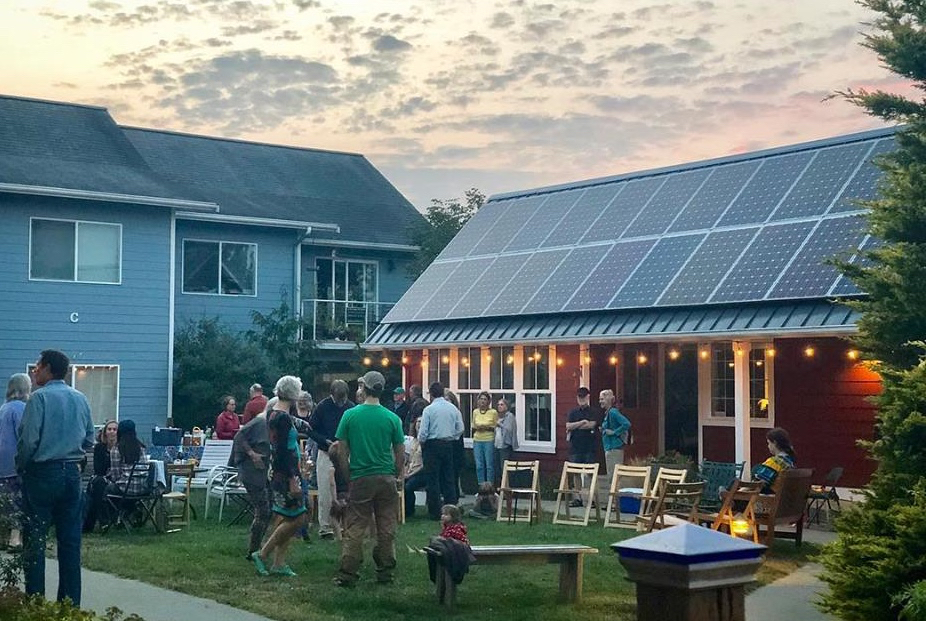
The Fifth Street Commons is a developer-initiated project that blossomed into an engaged community after residents moved in. They come together around regular shared meals, movie nights, garden work parties, social events, and put tools into practice for group decision-making and dispute resolution.
All during the research and writing of my book about pocket neighborhoods, I asked, ‘what is the right size of a pocket neighborhood?’ I was aware that cohousing communities typically have 20–30 households, a number that advocates believe to be optimum – large enough to have a diversity of residents and social coherence, yet not too large where decision-making becomes cumbersome. My sense was that pocket neighborhoods were smaller – with 6–10 households (more or less), which is a natural scale of sociability among humans. These are one’s closest neighbors who relate informally during the comings and goings of daily activity. Then I recognized that most (but not all) cohousing communities are configured with a series of pocket neighborhood-like clusters. The larger community is an aggregate of smaller subgroups. My hunch is that this was design by common sense, rather than an intentional social configuration.
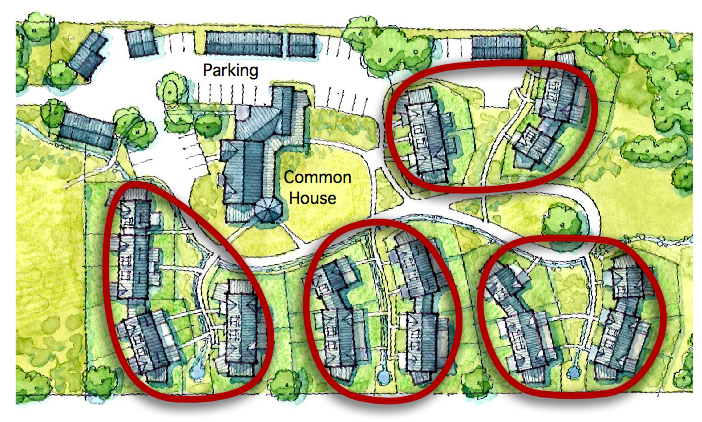
Pocket neighborhood clusters within a cohousing community.
Cohousing, with its larger size and its emphasis on community, will usually have a large (3000–5000 SF) common house with a commercial kitchen, community dining room, living room, guest rooms, children’s playrooms, workshop, exercise gym, and more.
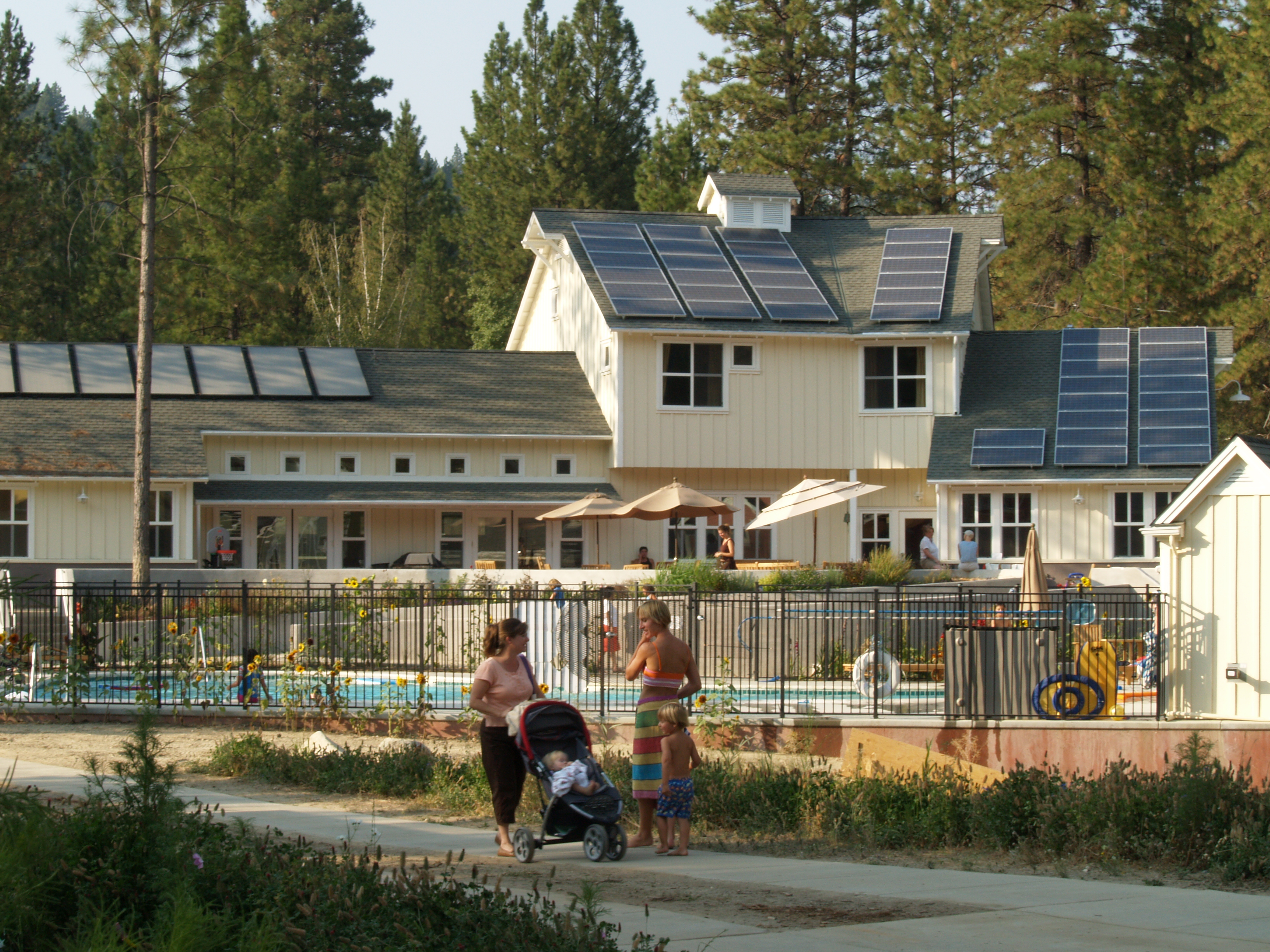
Cohousing common houses often have extensive spaces and amenities to serve the community. (Common House at Nevada City Cohousing)
Pocket neighborhoods are usually more modest, but nearly always have a place where nearby neighbors can come together – such as a picnic shelter or open-air barbecue. If budgets allow, they may have a four-season community room with a kitchen and bathroom, and perhaps a guest room. They almost always have a shared toolshed.
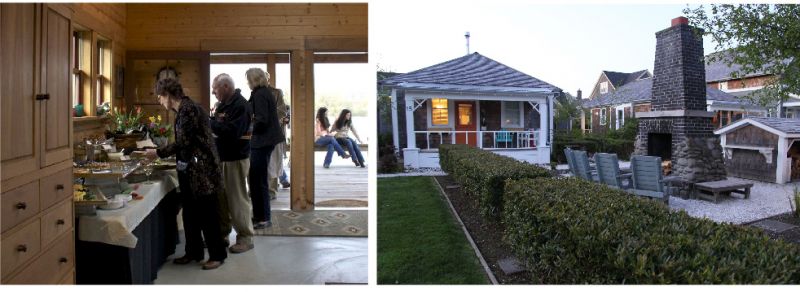
Pocket neighborhoods often have more modest common gathering spaces than cohousing communities, such as a community room or outdoor fireplace. (left: Salish Pond Cottages; right: Seabrook)
Whether a pocket neighborhood stands on its own, or is a sub-cluster of a larger cohousing community, the social size of the cluster supports their cohesion. Of course, other patterns factor in to their design, but an essential ingredient is the particular scale at which neighborly relations tend to blossom.
Hope this helps. Please chime in with your perspective and experience.
—Ross Chapin
*post script: the US Cohousing Association recently updated their definition of cohousing, loosening the requirement that residents be involved in planning their communities to use the term “cohousing”. A common house is not a requirement either, though there is an expectation to have ample common amenities.


I’m so glad I came across this site! I am all about community, but have never heard of pocket-neighborhoods until today. That is exactly what I have been looking for, but I didn’t know there was a term for it apart from “intentional community”. I’ll definitely be looking into your book for further insight. This concept has not reached my mid-size city here in Missouri (as far as I know!), but it is at a place now where many people would jump at this kind of thing if it were introduced. I lead a community group and will definitely bring it up next time.
I stay at a pocket neighborhood while planning a new Cohousing community. About twenty days and nights altogether so far. By my calculations there is about one-hundredth the social interaction in that pocket neighborhood as there is in a high functioning cohousing community like the one that I live in. Neither is right or wrong, but despite appearances they are just different. I love Ross and his aesthetic capabilities (my design mandate for the cohousing is to make it as pretty as the pocket neighborhood) but I wish that when people talk about architecture though that it was not just vague platitudes. There are many available metrics here. For example the host couple at the pocket neighborhood tells me that they’ve had a person come to the front door from the community unannounced about three times in five years. At the cohousing they can expect that to happen about ten times per week. I’m estimating about about 50 people hours in their current common building per week, and calculate 350-450 in the Nevada city cohousing community common house. One of the many reason that Cohousing started so successfully in Denmark is that ther were many practicing anthropologists involved. They carefully measured that if we do this that will happen, if we do that this will happen based on the careful observations of that discipline. This is pretty easy data to obtain. I’m hoping to engage more measurables into the conversation in the future.
Thanks much, Charles Durrett
*Btw the cohousing definition is not changed. The network did not come up with the definition of a coined word in the first place, so they don’t get to change it. They are welcome to call places without a common house whatever they please, but it’s not cohousing.
Charles,
Thanks for your perspective, and your inspiration.
I will be the first to say that some pocket neighborhoods function socially better or worse than others, for various reasons. Perhaps the same can be said of cohousing. I think there is something to learn from both.
In this blog post I defined a pocket neighborhood as a cluster of nearby neighbors around a shared commons. Many cohousing communities have pocket neighborhoods within them. To come down on pocket neighborhoods as socially low functioning is to miss what pocket neighborhoods are.
I think you mean to compare intentional communities and neighborhoods of proximity. The data measurables will likely highlight major differences. I would like to see more neighborhoods come together as intentional communities, even among residents moving in after the buildings are built. Cohousing folks have been working on tools for social cohesion for decades. Let’s apply these as widely as possible!
Regarding aesthetics, when we’re designing neighborhoods, houses and gardens, we are only secondarily concerned with how “pretty” they are or what their style is. We focus on getting the ‘bones’ right as to how the design supports both privacy and community. If we do our job right, the beauty that emerges will be more than skin deep.
I found this blog post excellent and thought-provoking. It never occurred to me, but indeed my cohousing neighborhood (Shadowlake Village in Blacksburg, VA) and many of the 20+ others I’ve visited include pocket neighborhoods. They often gain a character based on the residents who live there. The 11 home South Node, where I live is comprised of many families with kids and is where spontaneous get-togethers often occur. The North Node is a mix of singles and families and has a completely different nice character, and the East Node with scenic views has many active retired couples.
Cohousing needs to have at least 24 or so households so that there are enough people around to support community activity when a few households are out of town or on vacation. But breaking it into pockets is natural. Thanks for this thought.
I’m also excited about the new definition of cohousing (see the post script with hyperlink above). I don’t believe people should have to almost fail and go through the dark night of the soul together to create cohousing from scratch as novices. They should be able to meet up with likeminded people, write a check, buy a cohousing house, and then dive into the cohousing lifestyle and build the nonphysical aspects of community that are really what its about. Architecture fosters community but residents don’t need to design the architecture to build the community.